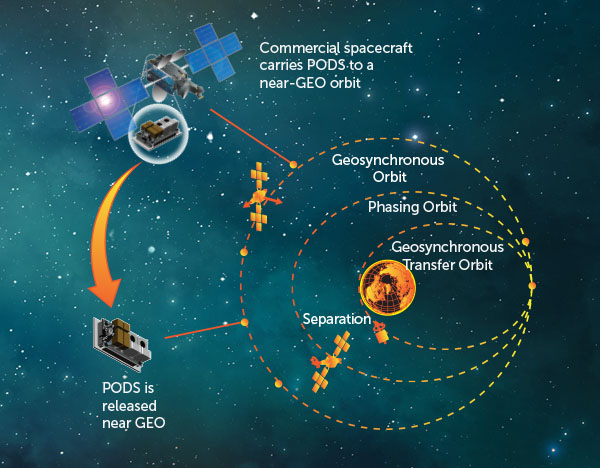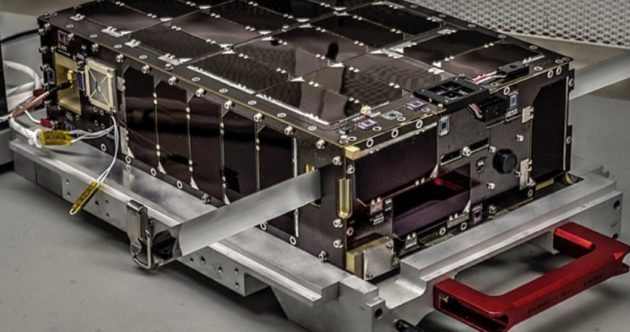NASA has selected a unique mission to study the Sun, targeting a 2023 launch date.

NASA
A new NASA mission will look at space weather in an effort to characterize solar particle storms and their effect on the local space environment. NASA has granted $62.6 million to design, build and launch this mission by no earlier than July 1, 2023.
The Sun Radio Interferometer Space Experiment, or Sunrise, will consist of a set of six free-flying 6U CubeSats, each about the size of a small toaster. Since a minimum of four satellites are needed to meet science requirements, the array essentially has two on-orbit spares. Each satellite will deploy a pair of solar panels for power and multiple antennas for communication and data collection once in orbit.
The satellites will be spaced within about 10 km (6 miles) of each other and will observe low-frequency radio waves that would be blocked by Earth's atmosphere. As each satellite images radio emission from solar activity, this data will be combined in a process called interferometry, so that the six units essentially act as one enormous radio telescope.
Justin Kasper of the University of Michigan will lead the Sunrise mission, which is managed by NASA's Jet Propulsion Laboratory. (Kasper is also the principal investigator of an instrument aboard the Parker Solar Probe.)

SSL / Maxar Technologies Inc.
The Sunrise array will orbit Earth once every 25 hours in a super-geosynchronous orbit, 300 to 1000 kilometers above standard geosynchronous orbit. This is also sometimes referred to as a "graveyard orbit," because it is where geosynchronous satellites go at the end of their operational lives. The space technology company Maxar will deploy Sunrise in its super-GEO orbit using the Payload Orbital Delivery System .
Sunrise Science
“Sunrise is designed to measure the location and shape of the source of radio emissions associated with coronal mass ejections (CMEs),” says Jim Lux (NASA-JPL). CMEs are explosions near the Sun's surface that release particles and radiation into interplanetary space, with consequences for astronauts and satellites alike.
Sunrise's radio array will track these solar particle bursts as they expand away from the Sun and hurtle out through the inner solar system. By tracing the bursts back to their origin, scientists hope to understand how and where these giant particle jets begin, and what accelerates them to such high speeds.
The array will also map the magnetic field lines of the Sun, for the first time tracing these lines as they go from the Sun's surface to interplanetary space. This capability will enable the mission to track magnetized plasma as well as particle radiation.
Sunrise will provide vital data for future long-duration missions to the Moon and Mars. Mars Curiosity carried a particle detector in part to study the radiation environment en route to the Red Planet in 2012, and what it found was grim: Radiation and energetic particles pose a threat that NASA will have to prepare for before astronauts can head to Mars. Sunrise will help improve predictions of when and where particles and radiation from a given CME would arrive.
The Sunrise array uses an interesting method to observe targets. Basically, each satellite's detector will record radio signals from everywhere nearly continuously. The array will then downlink the data and processing on the ground will locate sources, essentially "pointing" the array after the fact.
A student team also plans to use Sunrise observations to look at radio bursts from Jupiter and possibly other outer planets as well.
Synergy with Sunrise
Sunrise, which has a primary mission projected for one year, will work in tandem with other ongoing solar missions when it launches in 2023.
“Both Parker Solar Probe and Solar Orbiter can image coronal mass ejections in visible light,” Kasper says. “We can ‘paint’ our radio images on top of their images of the overall eruption to figure out where the acceleration of particles to high energy is happening.”
Both Parker and Solar Orbiter are also equipped with onboard radiation detectors, enabling researchers to see just how widespread an event is. Parker will get close enough to the Sun to see radio emission events as they pass over the spacecraft.
“We will have our remote images of the big picture and a local measurement by Solar Probe to compare (them) with,” says Kasper. “It’s going to be fantastic to be able to compare the observations from these different locations.”

NASA
Sunrise was one of two missions selected in 2017 under NASA’s Explorer Missions of Opportunity program. The other mission to be selected in this process was the Atmospheric Waves Experiment (AWE), which will study gravity waves in Earth's atmosphere from the International Space Station starting in 2022.
It will be fascinating to watch the Sunrise mission unfold, as the Sun ramps up its magnetic activity during Solar Cycle #25.
 1
1









Comments
Anthony Barreiro
April 3, 2020 at 9:05 pm
"Mars Curiosity carried a particle detector in part to study the radiation environment en route to the Red Planet in 2012, and what it found was grim: Radiation and energetic particles pose a threat that NASA will have to prepare for before astronauts can head to Mars."
Given the devastating health effects of ionizing radiation, microgravity, and prolonged isolation in cramped quarters, interplanetary human space flight seems untenable. None of these factors are a problem for robots, plus robotic probes are millions of times cheaper and more cost-effective than any potential interplanetary human mission.
Just send robots.
You must be logged in to post a comment.
You must be logged in to post a comment.